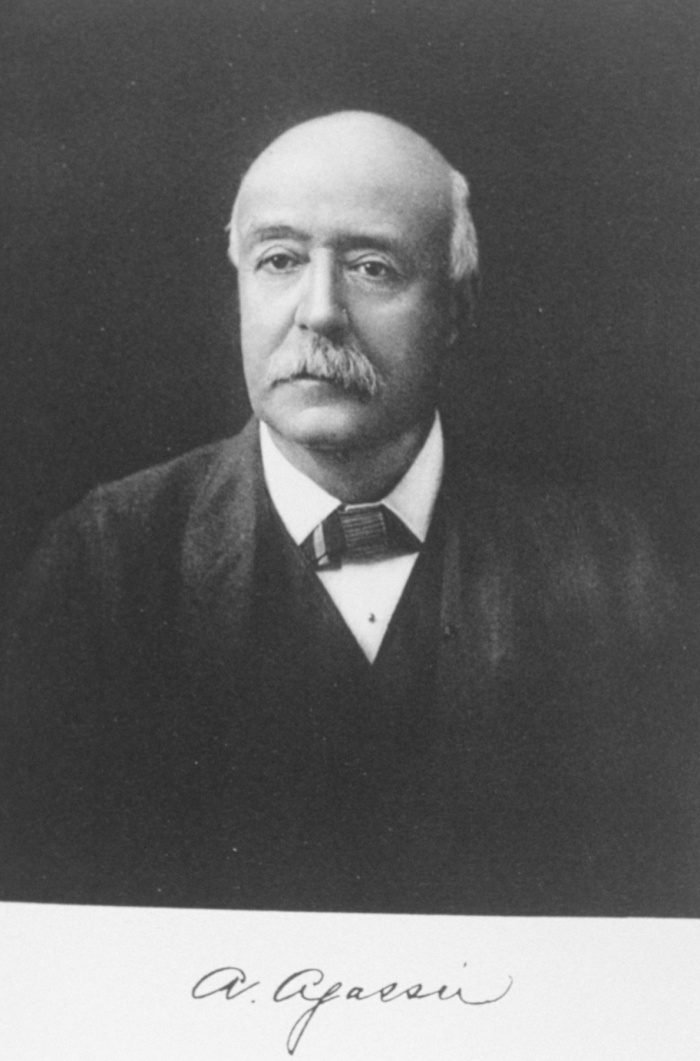- Alexander Emanuel Agassiz
Infobox Scientist
name = Alexander Emanuel Agassiz

image_width = 200px
birth_date = birth date|1835|12|17|df=yes
birth_place =New York City, New York , USA
death_date = death date and age|1910|03|27|1835|12|17|df=yes
death_place = at sea aboard the SS "Adriatic"
nationality =Switzerland ,United States
field =Chemistry ,engineering
work_institutions =United States Coast Survey
alma_mater =Harvard University
doctoral_advisor =
doctoral_students =
known_for =
influences =
influenced =
prizes =
footnotes =Alexander Emanuel Agassiz (
December 17 ,1835 –March 27 ,1910 ), son ofLouis Agassiz and stepson ofElizabeth Cabot Agassiz , was an American scientist and engineer.Biography
Agassiz was born in
Neuchâtel ,Switzerland and emigrated to theUnited States with his father in 1849. He graduated atHarvard University in 1855, subsequently studyingengineering andchemistry , and taking the degree ofbachelor of science at theLawrence scientific school of the same institution in 1857; and in 1859 became an assistant in theUnited States Coast Survey .Thenceforward he became a specialist in marine
ichthyology , but devoted much time to the investigation, superintendence and exploitation of mines.E. J. Hulbert , a friend of Agassiz's brother-in-law,Quincy Adams Shaw , had discovered a rich copper lode known as theCalumet conglomerate on theKeweenaw Peninsula Lake Superior inMichigan . He persuaded them, along with a group of friends, to purchase a controlling interest in the mines, which later became known as theCalumet and Hecla Mining Company based inCalumet, Michigan . Up until the summer of 1866, Agassiz worked as an assistant in the museum of natural history that his father founded at Harvard. That summer, he took a trip to see the mines for himself and he afterwards became treasurer of the enterprise.Over the winter of 1866 and early 1867, mining operations began to falter due to the difficulty of extracting copper from the conglomerate. Hulbert had sold his interests in the mines and had moved on to other ventures. But Agassiz refused to give up hope for the mines, and he returned to the mines in March 1867 with his wife and young son. At that time, Calumet was a remote settlement, virtually inaccessible during the winter and very far removed from civilization even during the summer. With insufficient supplies at the mines, Agassiz struggled to maintain order, while back in Boston, Shaw was saddled with debt and the collapse of their interests. Shaw obtained financial assistance from John Simpkins, the selling agent for the enterprise to continue operations.
Agassiz continued to live at Calumet, making gradual progress in stabilising the mining operations, such that he was able to leave the mines under the control of a general manager and return to Boston in 1868 before winter closed navigation.
The mines continued to prosper and in May 1871, several mines were consolidated to form the
Calumet and Hecla Mining Company with Shaw as its first president. In August, 1871, Shaw "retired" to the board of directors and Agassiz became president, a position he held until his death.Agassiz was a major factor in the mine's continued success and visited the mines twice a year. He innovated by installing a giant engine, known as the Superior, which was able to lift 24 tons of rock from a depth of 1,200 metres (4,000 ft). He also built a railroad and dredged a channel to navigable waters. However, after a time the mines did not require his full-time year-round attention and he returned to his interests in natural history at Harvard.
Out of his copper fortune, he gave some US$500,000 to Harvard for the museum of comparative
zoology and other purposes.In 1875 he surveyed
Lake Titicaca ,Peru , examined thecopper mines of Peru andChile , and made a collection of Peruvian antiquities for theMuseum of Comparative Zoology , of which he wascurator from 1874 to 1885. He assistedCharles Wyville Thomson in the examination and classification of the collections of the 1872 "Challenger" Expedition, and wrote the "Review of the Echini" (2 vols., 1872-1874) in the reports.Between 1877 and 1880 he took part in the three
dredging expeditions of the steamer "Blake" of the Coast Survey, and presented a full account of them in two volumes (1888).In 1896 Agassiz visited
Fiji andQueensland and inspected theGreat Barrier Reef , publishing a paper on the subject in 1898.Of Agassiz's other writings on marine zoology, most are contained in the bulletins and memoirs of the museum of comparative zoology; but he published in 1865, with
Elizabeth Cary Agassiz , his stepmother, "Seaside Studies in Natural History", a work at once exact and stimulating, and in 1871 "Marine Animals of Massachusetts Bay".Agassiz served as a president of the National Academy of Sciences, which since 1913 has awarded the
Alexander Agassiz Medal in his memory. He died in 1910 onboard the SS "Adriatic" en route to New York fromSouthampton .Publications
*
*
*
*
*
*
*
*
*
*
*ee also
*
Agassiz family References
*
*cite news | author=Staff writers | title=Prof. Agassiz Dies on Liner at Sea | url=http://article.archive.nytimes.com/1910/03/30/105076489.pdf?AWSAccessKeyId=0KENS5FNHEZD25CVYR82&Expires=1204741275&| work=The New York Times | date=30 March 1910 | accessdate=2008-03-05
External links
* [http://www.mininghalloffame.org/inductee.asp?i=26&b=inductees%2Easp&t=n&p=A&s= National Mining Hall of Fame: "Alexander Agassiz"]
Wikimedia Foundation. 2010.
